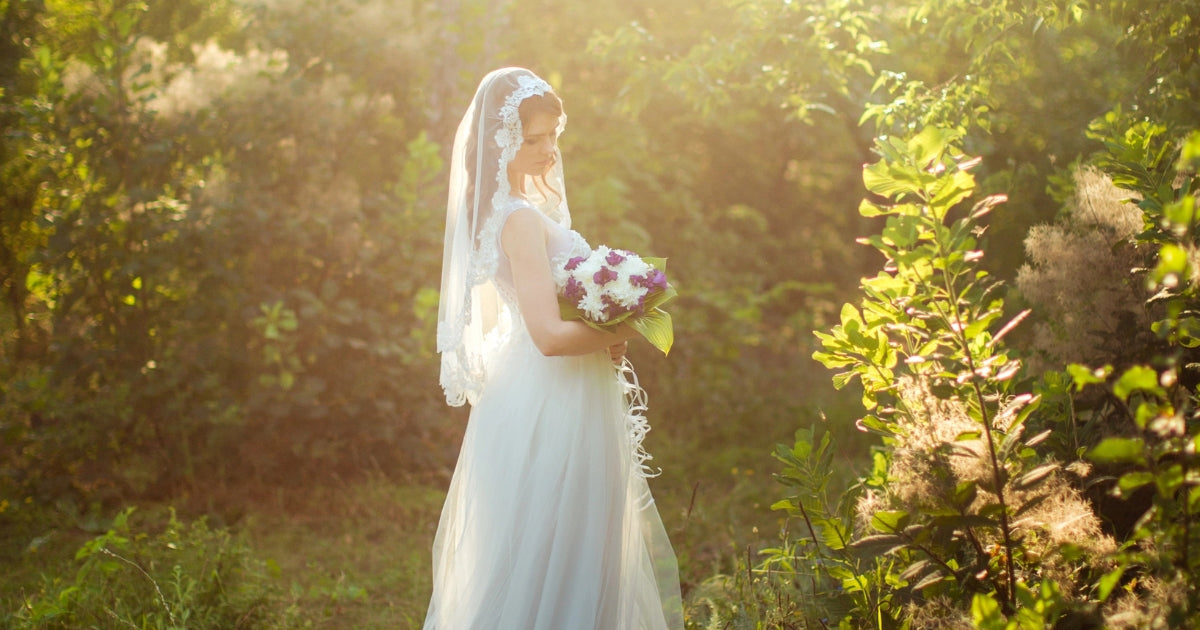
What Is a Mantilla Veil? Origins and Traditions
|
Time to read 4 min
|
Time to read 4 min
A mantilla veil is a traditional lace or silk fabric draped over the head and shoulders, originating from Spain in the 16th century. This elegant head covering is characterized by its circular or oval shape that lies flat on the head without any gathering. Unlike standard wedding veils, mantillas feature distinctive lace-trimmed edges that frame the face and cascade down the shoulders.
The term "mantilla" derives from the Spanish word "manta," meaning "blanket," reflecting its early form as a decorative blanket before evolving into the accessory known today. Traditionally, mantillas are placed approximately two inches behind the hairline, often secured with a high ornamental comb called a peineta that adds height and drama to the overall appearance.
These veils are primarily crafted from fine tulle or netting with lace embroidery adorning the edges throughout the entire veil. The embellishments can range from delicate appliqués to bold embroidery. Mantillas gained significant popularity during the 17th and 18th centuries, particularly when Queen Isabella II of Spain began wearing them, establishing them as the epitome of fashion.
Throughout various cultures, mantilla veils maintain different styles and traditions. In Eastern Orthodox churches, white mantillas are worn with ends crossed over the neck and draped over the opposite shoulder. In traditional Spanish culture, they're worn atop the head with the peineta, while in wedding contexts, they're designed to frame the bride's face and cover her hair, shoulders, and back.
Though originally associated with religious ceremonies, mantilla veils have transcended their origins to become sophisticated wedding accessories appreciated for their timeless elegance and rich cultural heritage.
Mantilla veils come in numerous designs that vary in style, material, and embellishment.
Mantilla veils feature either full lace construction or lace trim designs. Full lace mantillas are crafted entirely from fine, lightweight Chantilly lace with intricate floral motifs creating a romantic, vintage-inspired appearance ideal for complementing clean-lined silhouettes. In contrast, lace-trimmed mantillas have a thick decorative lace edge surrounding a center of tulle or netting.
Length options for mantilla veils include multiple variations suited to different wedding styles. Cathedral-length mantillas flow several feet behind the bride, creating maximum drama ideal for formal weddings and gowns with long trains. Chapel-length mantillas, slightly shorter than cathedral length, offer elegance and movement without excessive weight. Furthermore, fingertip mantillas extend to the bride's fingertips, making them suitable for semi-formal weddings and modern silhouettes.
Contemporary mantilla veils incorporate modern touches that enhance their traditional beauty. Pearl embellishments add elegance and subtle sparkle, whereas colored lace in blush or champagne creates a soft, romantic aesthetic. Some designs feature embroidered personalization with initials, wedding dates, or meaningful quotes in the lace trim.
The primary distinction between standard veils and mantillas lies in their construction and placement. Unlike gathered veils, mantilla veils lie flat on the head without gathering in the fabric width and flow over the shoulders and down the back. Standard veils typically attach with a comb at the crown or back of the head, whereas mantillas are worn at the top of the head, approximately two inches behind the hairline, allowing the lace edges to frame the face and cascade down the shoulders.
The tradition of wearing mantilla veils extends back several centuries, embodying rich cultural heritage and profound religious symbolism that continues to resonate with modern brides.
Mantilla veils gained prominence in Spain toward the end of the 16th century, with lace versions becoming fashionable among women throughout the 17th and 18th centuries. Elite Spanish artists like Diego Velázquez and Goya frequently depicted these elegant head coverings in their portraits. Queen Isabella II significantly boosted their popularity in the 19th century by actively encouraging their use. Following her abdication in 1870, mantilla usage gradually declined, becoming primarily reserved for church services, bullfights, weddings, and Holy Week processions by 1900. Throughout Spanish culture, mantillas are considered so precious that current law deems them personal possessions that cannot be seized as payment for debts.
Mantilla veils represent the Spanish adaptation of Christian headcovering practices referenced in 1 Corinthians 11:2-10. Traditionally, black mantillas signified married or widowed status, while white mantillas indicated unmarried women. The veil carries profound spiritual meaning as an act of veiling physical beauty so God's beauty may be glorified instead. It also symbolizes the role of women as life-bearing vessels—similar to how the chalice holding Christ's blood is veiled until the Preparation of Gifts. Prior to the Second Vatican Council, Catholic women were required to wear veils during Mass as symbols of modesty and humility before God.
Modern brides select mantilla veils to honor cultural heritage while adding significant meaning to their wedding attire. The mantilla creates an instant connection to tradition, whether embracing Hispanic roots or appreciating European-inspired bridal fashion. Many Catholic brides choose these veils not merely as fashion statements but as acknowledgments of the sacredness of marriage. Their timeless elegance and photogenic qualities make them particularly appealing for wedding photography. Since high-quality mantilla veils preserve well and maintain their classic appeal through changing fashion trends, they often become cherished family heirlooms passed through generations.